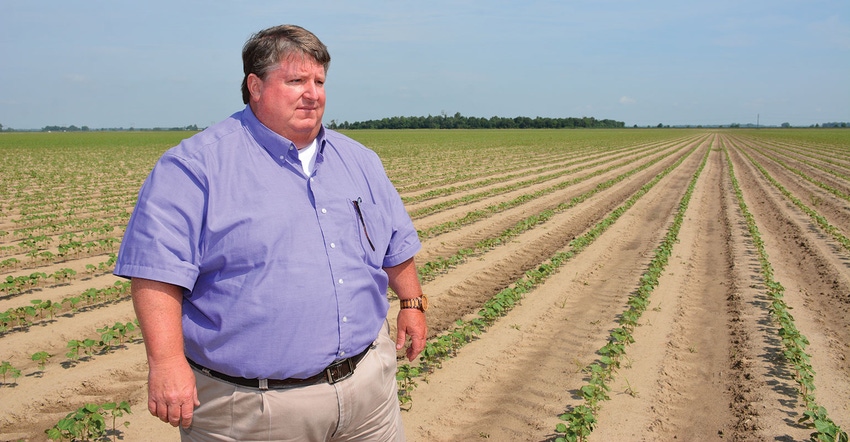
In 1922, Jimmy Turner’s great grandfather bought a 1,000-acre farm in Humphreys County, Miss., lock, stock and a yard full of poultry.
He bought the land, the buildings and some mules and chickens, says Turner, who now raises sweet potatoes, cotton and soybeans on about 2,300 acres of land near Belzoni, Miss. “He took a year to put enough money together and started farming the land in 1923,” Turner says of his great grandfather.
He figures cotton has been a part of the operation for years but likes his current mix of enterprises. “I like the crop mix,” he says. “Some years one may do better than the others with yield or price changes. We still have good years and bad ones.”
Soybeans take the bulk of the acreage at 1,300. Sweet potatoes are next with 625 acres, followed by cotton at 460 acres.
“Our biggest challenge is always the weather. At planting, we get delays, and too much rain at harvest causes problems. Getting a crop established is critical. The first two or three weeks after planting pretty well indicates what the crop will do.”
A wet spring delayed soybean seeding. “They’re a little later than normal. I like to plant soybeans the first week of April and be through by the end of the month. This spring, I would plant two days and it would get wet; I’d plant two days, and it would get wet again. I finished planting the first of May. But I have a good stand.”
He says warm weather helped the crop catch up a little.
“We planted cotton the last of April; it’s up and off to a good start. Lately, we’ve had good growing conditions. We had winter and then just bypassed spring and went to summer. Seed emerged quickly and cotton and beans are growing rapidly now.
“I’m working on 22 years growing sweet potatoes,” Turner says. “Transplanting is on schedule with some fields already showing a good stand. We are on target.”
Turner drove out to a field where crews were transplanting potato slips, a dozen or so workers seated on a planter pulled behind a tractor. They dropped potato slips into the rows as they moved across the field.
“Sweet potatoes are labor intensive,” Turner explains. “We need 45 workers to transplant and 70 to 80 at harvest. We use contract labor to bring in H-2A workers, and we get good labor through that program.”
He says transplant to harvest is 118 to 120 days, “to maturity to get the right size. We have a good market for sweet potatoes and Mississippi has a good reputation and market opportunities for sweet potatoes. We have a good climate and good soil for them.”
Good Rotation
It’s a good rotation option for cotton or soybeans, too. “We rotate sweet potatoes every year and they do well behind those crops. Beans and cotton are better options than corn. We get more worm pressure in the sweet potatoes if they follow corn.”
He’s not growing corn this year. “I would like to have corn in the rotation; it helps yield and soil structure, but the price has been too low.”
He says sweet potatoes use very little nitrogen or phosphorus but need a lot of potassium. “I balance fertility out with micronutrients. I apply most fertilizer mixed before planting and supplement with foliar applications in the growing season.
“Beans and cotton do well behind sweet potatoes and take advantage of residual fertilizer. And they get organic matter from the vines.”
Turner says sweet potatoes can hang on during short dry periods. “But if it stays dry for two weeks and the forecast calls for continuous dry weather, I irrigate. I am set up to irrigate everything (except pivot corners) when needed. I have pivot and furrow irrigation.”
Few diseases threaten sweet potatoes, but Turner says he keeps watch for insects before and after planting.
Cotton
Weather is the biggest obstacle he faces with cotton, too. Last year he had “too much rain in August and the first of September when I needed to be finishing the crop. I hope I have better conditions this year.”
He says cotton yields were off a little from his five-year average because of excess rainfall.
He’s growing DP 1646B2XF, but does not intend to use dicamba products to control weeds. He’ll use a combination of Roundup and Liberty with preplant and residual herbicides. It’s been a good program with a variety that has been one of the highest yielding varieties on the market for the last few years.
“Soybean weed control will be similar with preplant, residual herbicides and over-the-top combinations.”
He’s planting Asgrow AG46X6, Pioneer P47T36R and a local variety, Local Seed’s LS4565XS.
Best Soybean Crop
“Last year’s soybean crop was the best I’ve ever had,” Turner says. “A 65- to 70-bushel yield is a good bean crop.”
He uses a mixture of conventional and minimum till. “I usually work the soybean fields in the fall and then just drop in and plant.”
Turner likes his current crop mix. “All three are pretty dependable in the market,” he says. “I do my own marketing, cotton through Staple Cotton Cooperative and the beans to the elevator, either on contract or on the spot market.”
He likes the gaps in labor demand for the three crops, too. He starts in the spring with soybeans, then plants cotton and finishes up with sweet potatoes. Harvest begins with soybeans in late August. Sweet potato harvest usually comes in mid-September, and cotton pickers roll in around Sept. 15 to 20.
The mules and chickens Turners’ grandfather bought may not be a big part of his 2018 farmstead, but 2,300 acres of cropland, including a labor intensive one, show that diversification, good management, and good land assure that progress continues almost 100 years later.
About the Author(s)
You May Also Like






